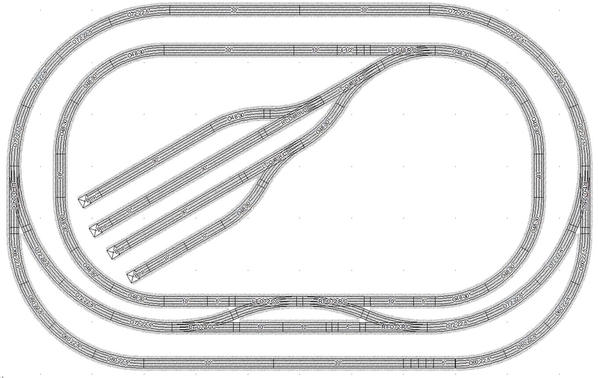Vin,
Everyone above is correct so far. Here's more detail.
1.) Track Connections -- Assuming you're intending to control the conventional locos on the two loops independently, and by using a CAB-x handheld, you'll need two PowerMasters, or the non-Lionel equivalent of them from back in the day, IC Controls' TPCs. Since Lionel later bought the rights the TPC design from IC Controls there are also Lionel TPCs available on the used market. For your layout you could use the same make and model on both loops for sake of convenience. On the other hand if you want to be frugal you can use two different ones of either type, and even mix types, assuming you can used ones at a good discount. Each one will need to be set up with an independent address or ID# as part of firing everything up.
2.) Power Source -- A PowerMaster or TPC is a only a throttle. It needs an AC power source to provide power to it, which it then controls and feeds to the track to run the train. This source can be of many types. One is a PowerHouse, like a PH-180, or the older and less powerful PH-135, which are fixed AC power supplies of approximately 18 VAC. Another could be an old-fashioned transformer like a KW or ZW, with its handle turned all the way up, or nearly so, to get the 18 VAC.
3.) Handheld Controller -- It also needs a handheld controller (CAB-1, 1L, or 2) from which to receive the instructions for control. CAB-1 only works with Base-1; CAB-1L works with Base-1L or Base-2; CAB-2 works with Base-2.
4.)Operating Conventional Equipment -- With this setup when you put a conventional locomotive on either loop use the CAB-x's knob to vary the voltage to the track and run the train just like you would by using the lever on a old-fashioned transformer, but now in the palm of your hand. Just make sure that you select the proper PowerMaster or TPC device by entering it's Address/ID No. on the CAB-x before attempting to control it.
5.)Operating Command-Control Equipment -- Because command locomotives run on fixed voltage, and not variable, with this setup when you put a command control locomotive on either loop you must first issue a command to your PowerMaster, or TPC, on that loop to go to full voltage output for that loop, one way is by turning the knob on the CAB-x to maximum, and you're ready to run it. You'll run it by next selecting the engine, by pushing the ENG button on the CAB-x and then typing the ID Number for that engine. Afterward the knob will control its speed and not the PowerMaster/TPC (until you reselect it).
6.) Sidings -- Your suggestion of using toggle switches for the sidings will be OK. These switches simply need to connect the siding's center rail to that of the loop track to which they connect. Turn one on to pull a train into or out of a siding. Turn it off once fully in, or fully out. Be sure to remove the track pin for the center rail at the point the siding connects to its loop.
7.) Power Protection -- Fuses, Circuit Breakers, or Electronic Overload Protection. This is big topic with several threads on this forum dedicated to it.
See, for example:
Airpax Snapac Hydraulic-Magnetic Circuit Breaker Internal Mechanisms - Updated 5/12/2021 | SteveH
or
ZW to PowerMaster to PSX1-AC to legacy BPC2 to track | RMMorrow
All seven steps above work for either TMCC or Legacy or both, but using a CAB-2, instead of a CAB-1 or 1L, in Step 3 works best for Legacy.
Let us know if you have any more questions.
Mike
![]() I'm going to post more of an intro in the layout section about my past, current, and future layouts, but for now I had a few questions I hope to get some help with. Or at least pointed in the right direction.
I'm going to post more of an intro in the layout section about my past, current, and future layouts, but for now I had a few questions I hope to get some help with. Or at least pointed in the right direction.





